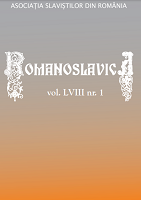USMENOKNJIŽEVNI / MITSKI I BALADESKNI INTERTEKST U ROMANIMA IMOTSKI KADIJA IRFANA HOROZOVIĆA I ŽENA CRVENE KOSE ORHANA PAMUKA
Oral literary / Mythical and baladesque intertext in the novels 'Imotski kadija' by Irfan Horozović and The Red-Haired Woman by Orhan Pamuk
Author(s): Fatima TrbonjaSubject(s): Customs / Folklore, Bosnian Literature, Turkish Literature, Theory of Literature, Sociology of Literature
Published by: Asociația Slaviștilor din România
Keywords: intertextuality; myth; ballad; epic song; oral literary intertext; prototext; Irfan Horozović; Orhan Pamuk; Imotski kadija; The Red-Haired Woman;
Summary/Abstract: The paper will present the mythical, epic and baladesque elements which, in specific ways, participate in constructing the oral literary intertext in the novels 'Imotski kadija' by Irfan Horozović and 'The Red-Haired Woman' by Orhan Pamuk. Although it is noticeable that texts have always established connections with other texts of literature and culture, intertextuality as a technique began to be interpreted only in the sixties of the last century, when post-structuralists raised the question of the autonomy of the literary work, i.e. the text. In literary theory, we can trace the concept of intertextuality from Bakhtin (thesis on dialogue), Julia Kristeva (mosaic of quotations), through Barthes (theory of text) and Genette (intertextuality within transtextuality), to Croatian and Slovenian theorists Viktor Žmegač, Pavle Pavličić, Dubravka Oraić Tolić and Marko Juvan. As a dominant feature of postmodern culture, intertextuality is particularly significant in postmodern novels such as the ones written by, among others, the Bosnian author Irfan Horozović and the Turkish Nobel laureate Orhan Pamuk. The establishment of an intertextual dialogue with forms of oral literature (myth, epic song such as the one in the novel The Red-Haired Woman and ballad in the novel Imotski kadija) is noticeable. In Pamuk's novel, the ancient myth of Oedipus and the Iranian national epic Shahnama (a passage about Rustem and Suhrab) are intertextually present, while in Horozović's novel there is a clear allusion to the Bosnian ballad about Hasanaginica already in the title. The paper will show the ways of using the mentioned texts of the oral cultures of the East and the West in the construction of novelistic narratives.
Journal: Romanoslavica
- Issue Year: LVIII/2022
- Issue No: 1
- Page Range: 16-30
- Page Count: 15
- Language: Bosnian

